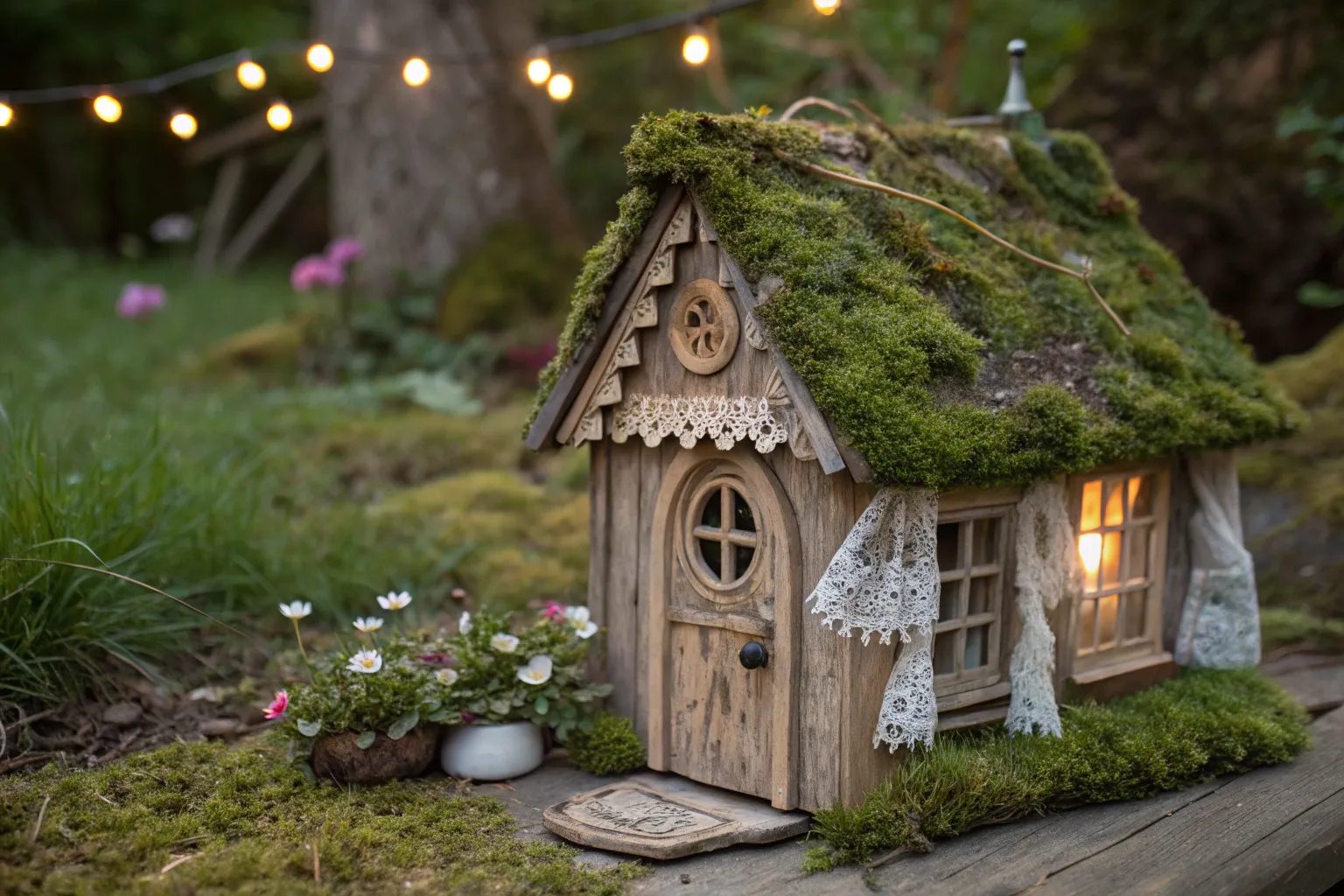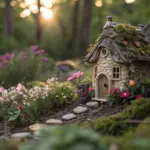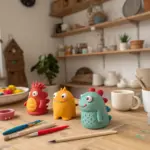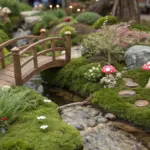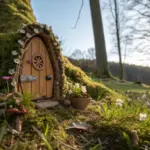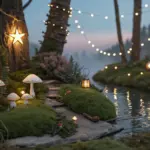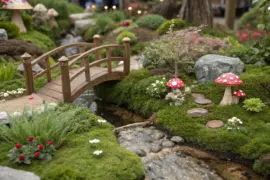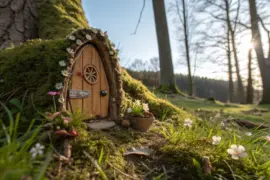Step into the world where tiny doors swing open to reveal enchanted rooms and moss-covered roofs shelter imaginary guests. Creating a fairy home is about bringing a little magic into everyday spaces—whether nestled in your garden or perched on a windowsill.
Beginning With the Bones: Walls That Tell Stories

Before you think about shingles or shutters, you need sturdy walls that can hold your vision. The foundation of any fairy home starts here, and the wonderful news is that you probably already have what you need.
Cardboard becomes your canvas. For beginners, corrugated cardboard from cereal boxes or shipping materials works beautifully. Layer several pieces together with hot glue or tacky glue for thickness and strength. The corrugated texture actually adds character—those subtle ridges can mimic wood grain or aged plaster once painted. Cut your wall pieces first, trace out door and window openings with pencil, then assemble the basic structure before adding details.
Bringing texture to life. Once your walls stand firm, you can transform plain cardboard into something that looks centuries old. For stone cottage walls, try the egg carton method: tear apart cardboard egg cartons into small, irregular pieces and glue them across your walls in a staggered pattern. The natural texture of the egg carton creates surprisingly realistic stone. Paint with a gray base coat, then add shadows with black or dark brown and highlights with white or cream to make each “stone” pop.
Another approach uses texture paste applied through a stone stencil, creating raised dimensional surfaces that catch light like real masonry. For wooden plank walls, glue thin cardboard strips vertically or horizontally, slightly overlapping them. When painted in browns and tans with darker lines between planks, the effect is remarkably convincing.
I’ve found that mixing your paint colors—never using just one shade—makes all the difference. Real walls weather unevenly, with darker patches where rain hits and lighter areas kissed by sun. Think about where your fairy might hang a lantern or where climbing vines might leave their mark.
Windows: The Eyes of Your Fairy Home

Windows bring personality to any structure. They hint at warm rooms within and catch light in ways that make miniature homes feel genuinely inhabited.
Simple frame techniques. For beginners, popsicle sticks or small wooden craft sticks create perfect window frames. Cut them to size with scissors or garden shears, arrange them in a rectangle or arch shape, and glue together with wood glue. Paint before attaching to your walls—soft creams, weathered grays, or even cheerful blues work beautifully. A tiny dab of dimensional paint on each corner suggests old nail heads or decorative details.
Thin twigs from your yard also make wonderful natural window frames. Choose relatively straight pieces, trim them to matching lengths, and bind the corners with a tiny dot of hot glue. The irregular texture of real wood brings authenticity that’s hard to match.
Creating the glass. Real glass isn’t necessary—and can be tricky to work with at small scales. Large flat glass gems or marbles create the look of thick, old-fashioned glass panes that catch and reflect light. Clear plastic from packaging, small pieces of transparency film, or even clear cellophane work well too. For a frosted or aged effect, paint the back of your “glass” with a very thin wash of white or cream acrylic paint.
Feeling ambitious? Try a tiny stained glass window by painting designs directly onto clear plastic with dimensional paint or permanent markers, then framing it with dark-painted sticks to mimic leading. The effect is magical when light filters through.
Placement matters. Windows should feel proportional to your structure. Generally, a window opening should be about one-quarter to one-third the height of your wall. Too large, and the wall loses structural integrity; too small, and they disappear. Arrange them asymmetrically for a more organic, cottage-like feel rather than perfectly centered.
Doors: Portals to Possibility

A door is more than an entrance—it’s an invitation. It’s where you imagine your fairy pausing before stepping out into morning dew, or returning home as twilight falls.
Classic plank door construction. The simplest fairy door uses five to seven popsicle sticks arranged vertically side by side. Glue them onto two horizontal support sticks on the back to hold them together, creating that classic barn door or cottage door look. For added character, cut the tops at angles to form a pointed arch, or keep them straight for a rectangular opening.
Paint your door before adding hardware. Earth tones—mossy greens, weathered browns, soft reds—feel naturally fairy-like, though soft blues and lavender purples work for more whimsical designs. Once dry, glue a small bead, button, or even a pinecone seed as a doorknob. Tiny brads or painted dots can suggest hinges.
Natural material alternatives. A piece of tree bark cut to door-size brings woodland charm. Flat strips of wood from craft stores, small wooden cutouts, or even thick chipboard painted and textured all work beautifully. If using bark, choose pieces that are relatively flat and dry—fresh bark may curl as it dries.
The details that delight. Once your door is in place, think about the small touches. A tiny doormat made from a scrap of felt or a miniature rectangle of sandpaper suggests welcome. Stack two or three small flat pebbles as a doorstep. A miniature wreath made from a bent piece of wire wrapped with moss or tiny dried flowers adds seasonal charm. Some crafters create tiny planters from acorn caps filled with moss, positioned on either side of the door like welcoming topiaries.
Remember, doors need to feel right for the scale of your structure. A six-inch-tall house might have a door that’s about three to four inches high. Your fairy should look like they could actually fit through—unless you’re creating a playful mismatch on purpose.
Roofs: Shelter and Style
The roof crowns your creation and often becomes its most distinctive feature. This is where you can really let creativity take over.
Shingle Roofs

Cardboard shingles offer wonderful flexibility and are genuinely beginner-friendly. Cut corrugated cardboard into thin strips, then snip those strips into small rectangles—aim for pieces about half an inch to three-quarters of an inch wide. Don’t make them all identical; varied sizes look more natural and aged.
Before gluing, paint your shingles in varied shades. Mix several browns, grays, or even dark reds and greens. Paint both sides so edges that hang over won’t show plain cardboard. This variation mimics how real roofs weather over time.
Application technique: Start at the bottom edge of your roof and work upward. Glue the first row with shingles slightly overhanging the edge. Each subsequent row should overlap the previous one by about half, hiding the glue line and creating that classic layered look. Stagger your shingles so the seams don’t line up vertically—offset each row by starting with a half-shingle or differently sized piece.
For the very top ridge of the roof, use slightly larger pieces or fold strips over the peak to cover both sides. This creates a finished, professional look.
Thatched Roofs

Thatched roofs bring storybook charm and work beautifully for cottages and rustic designs. Several materials can mimic thatch surprisingly well.
Moss creates an instantly magical thatched effect. Sheet moss or Spanish moss glued densely across the roof surface looks lush and organic. Apply a generous layer of tacky glue to your roof surface, press moss firmly into place, and trim any unruly bits with scissors once dry. The texture catches light beautifully and feels authentically woodland.
Artificial grass or teddy bear fur might sound unusual, but both work wonderfully. Cut artificial grass samples (often free from flooring stores) to fit your roof. Glue in place, then trim and shape with scissors. To make it look more like real thatch and less like grass, paint the entire surface with a mixture of Mod Podge and water, or brush on diluted PVA glue. This flattens the fibers, stiffens them, and creates a weathered appearance. Once dry, dry-brush with lighter browns or tans to add highlights and depth.
For teddy bear fur, follow a similar process—glue it down, then coat with thinned Mod Podge to stiffen and mat the fibers. Add a strip along the top ridge of the roof as a cap for a more authentic thatched cottage look.
Natural fibers like plumber’s hemp, raffia, or unraveled brown yarn can create remarkably realistic thatch, though these techniques take more patience. Apply them in overlapping layers from bottom to top, gluing as you go. Once complete, trim with scissors or an electric shaver for evenness, then weather with paint washes.
Pinecone Scale Roofs
Pinecone scales—those individual pieces you can pull from a pinecone with pliers—make gorgeous natural shingles. They’re free, readily available, and create beautiful texture.
Pull apart a large pinecone (or several) with pliers, separating individual scales. Apply them just like cardboard shingles, starting at the bottom and working up, overlapping each row. The natural curve and color variation of pinecone scales creates instant character. You can leave them natural or paint them for different effects—silvery gray for aged wood, deep brown for weathered shingles, even mossy green for an overgrown cottage.
Finishing Touches: Bringing It All Together
Once your walls, windows, doors, and roof are in place, small details transform your structure from craft project to enchanted dwelling.
Chimneys made from small stacks of pebbles or shaped pieces of clay suggest warmth within. Glue them to the side or top of your roof. A tiny wisp of cotton ball can become chimney smoke for display purposes.
Climbing vines crafted from thin wire or string painted green, with small bits of colored paper or fabric as flowers, suggest the passage of time. Glue them ascending one corner of your house or framing a window.
Weathering and aging makes structures feel real rather than new. Once everything is assembled and base-painted, mix a very thin wash of black or brown acrylic paint with water (about one part paint to four parts water). Brush this over surfaces, letting it settle into cracks and crevices. Wipe away excess with a paper towel, leaving shadows in recessed areas. Then dry-brush highlights—dip your brush in white or cream paint, wipe most of it off, then lightly sweep across raised surfaces. This creates dimension and makes details pop.
Making It Last: Protection for Indoor and Outdoor Display
If your fairy home will live outdoors, weatherproofing extends its life dramatically.
For outdoor pieces, paint with acrylic paints formulated for outdoor use, then seal with several coats of Mod Podge Outdoor. Apply thin coats, allowing each to dry completely before adding the next. For particularly harsh climates with intense sun or heavy rain, add a final protective layer of clear UV-resistant spray sealer like Krylon UV Resistant Clear Coating.
Marine varnish or spar urethane provides heavy-duty protection for wooden elements and painted pieces that will face weather year-round. Apply outdoors due to fumes, and allow full drying time between coats.
For structures using cardboard, be realistic—even with sealing, cardboard eventually succumbs to moisture. Consider it a seasonal project, or keep it under a protective overhang where rain won’t directly hit.
Indoor fairy homes need less protection but still benefit from a light coat of regular Mod Podge or clear acrylic sealer, which protects paint and makes dusting easier.
Scale and Proportion: Making It Feel Right
You don’t need to be rigid about measurements, but keeping elements roughly in proportion helps create that magical sense of realism.
As a general guide, if you’re working with a fairy figurine that’s about five inches tall (roughly equivalent to a 1:12 scale, where one inch equals one foot in real life), your door should be around six to seven inches tall. Windows might be three to four inches. Furniture pieces like benches or chairs should look like your fairy could actually use them.
If you’re building without a specific fairy in mind, think about creating a house that’s six to eight inches tall overall for tabletop display, or larger—ten to twelve inches—for garden placement where it needs to hold its own among plants.
That said, sometimes intentional scale mismatches create whimsy. An oversized mushroom next to a tiny door suggests your fairy lives in a land where everything grows unexpectedly large. Trust your eye—if something looks odd, adjust it. If it delights you, it’s working.
Lighting: Adding Glow and Magic
Few things transform a fairy home like soft light glowing from windows at dusk.
LED tea lights are the simplest solution. Battery-operated versions tucked inside your structure before sealing the roof create a warm glow. For cork-style fairy lights (the kind on thin wire), you can thread them through window openings or tuck them inside before assembly, with the battery pack hidden on the back or bottom of the structure.
Solar-powered lights work beautifully for outdoor fairy homes. Small solar garden lights can be incorporated into roof designs or positioned nearby to illuminate your creation as evening falls. Some crafters build fairy houses directly onto solar light caps, creating structures that naturally glow when darkness comes.
For a stained glass effect in windows, place a small LED light or tea light inside while positioning colored transparent material in the window frame. The light filtering through creates genuinely magical effects.
Your Fairy Home Awaits
Creating miniature homes for imaginary inhabitants connects us to playfulness and wonder—things we need more of, regardless of age. Each tiny shingle, each carefully painted windowsill, each doorstep made of pebbles invites storytelling and presence.
Start simple. Choose one technique that speaks to you—maybe a cardboard cottage with egg carton stone walls and a moss roof. As you work, you’ll discover what you enjoy most. Some people love the precision of shingle placement; others lose themselves in painting weathered textures. There’s no single right way to build these small worlds.
Gather your materials, set aside an afternoon, and begin. Your fairy home is waiting to take shape beneath your hands, ready to spark imagination in everyone who encounters it—including, perhaps most importantly, yourself.

